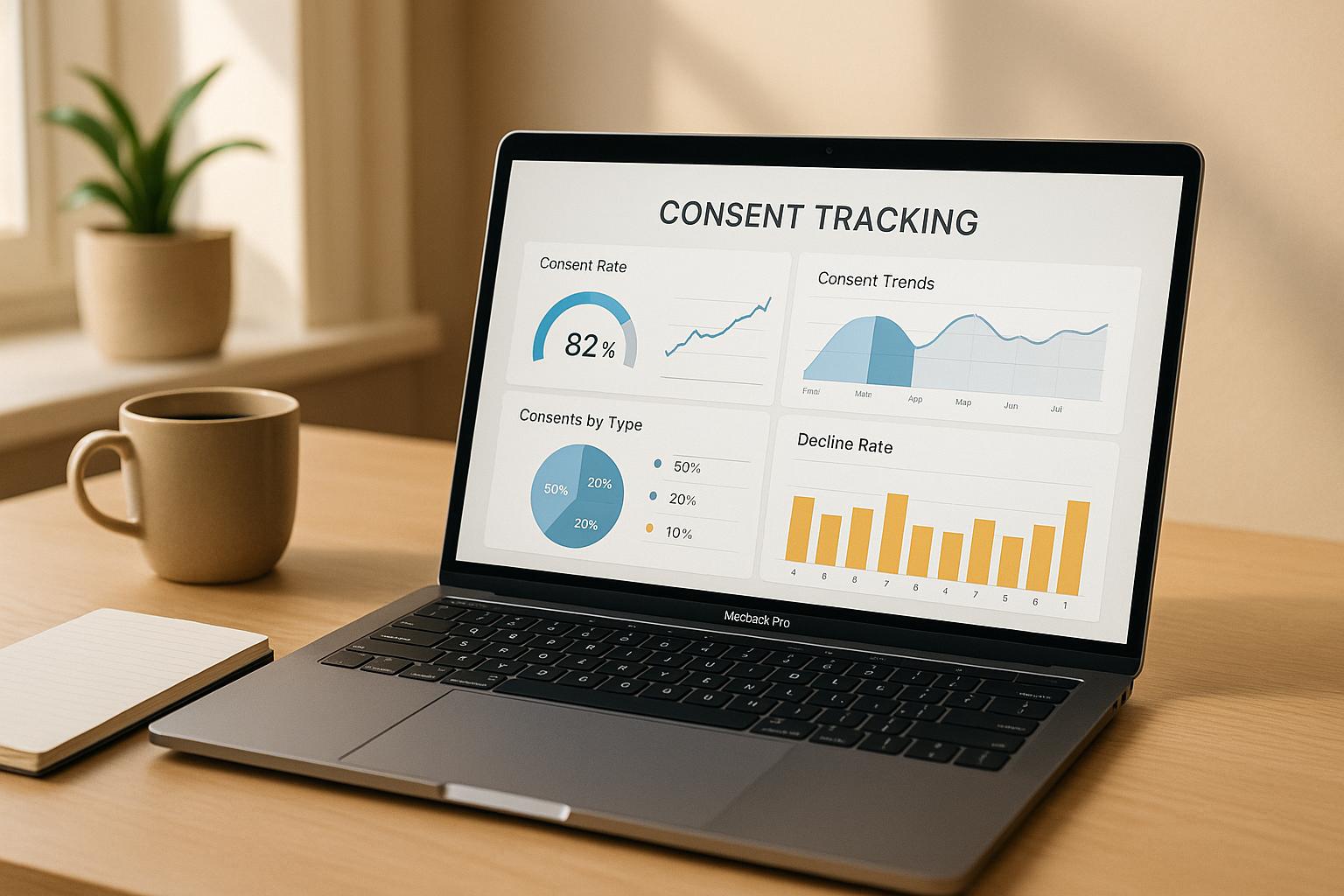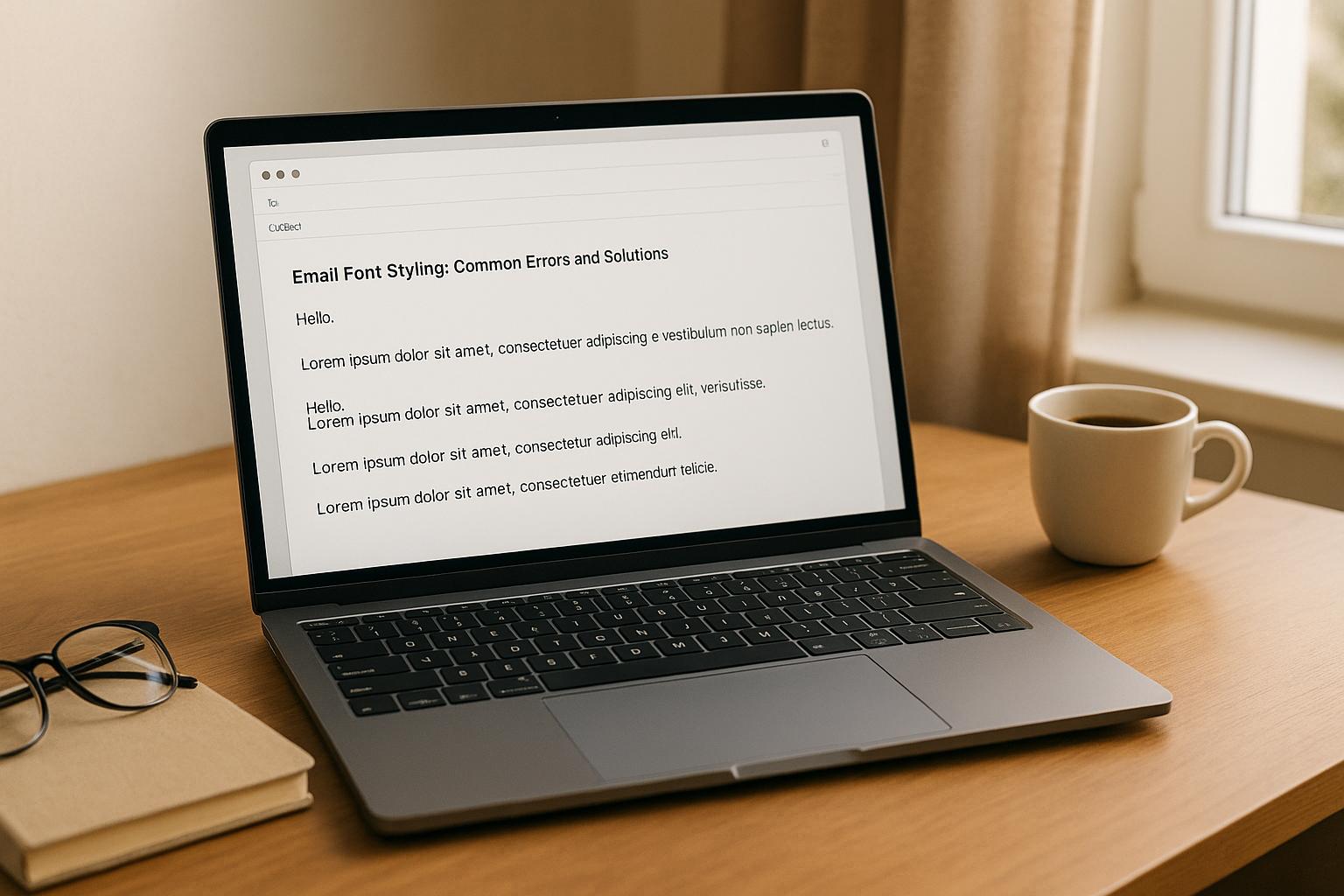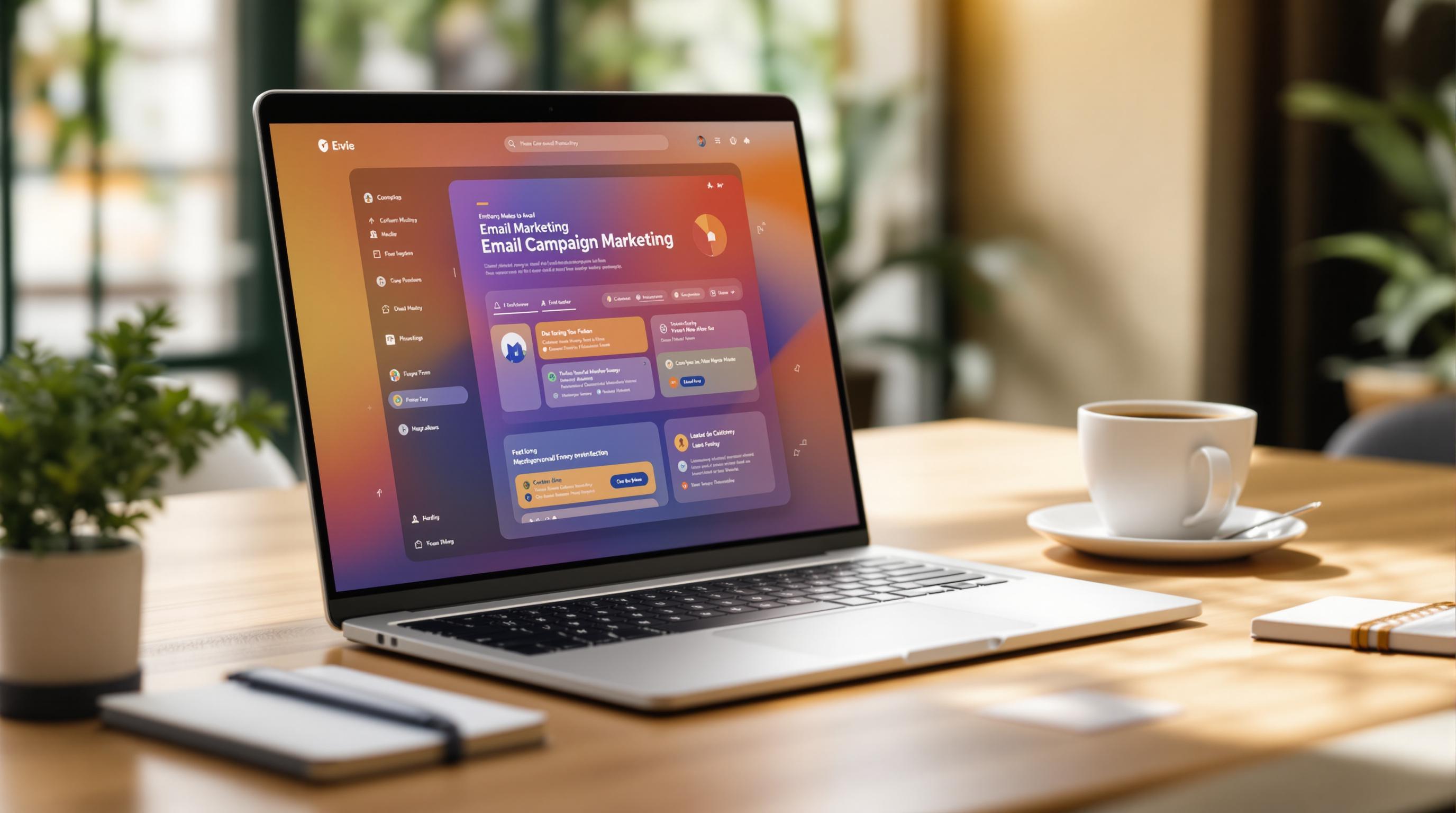Email marketing delivers an average ROI of $36 for every $1 spent, making it one of the most cost-effective marketing strategies. But choosing the right platform is key to maximizing your returns. Here’s a quick breakdown of the top 7 email platforms for ROI, tailored to different business needs:
- GetResponse: Best for advanced automation and precise segmentation. Pricing starts at $19/month.
- Moosend: Affordable and user-friendly, perfect for small to medium businesses. Starts at $9/month.
- ActiveCampaign: Ideal for businesses needing CRM integration and complex workflows. Starts at $15/month.
- Omnisend: E-commerce-focused with omnichannel marketing tools. Starts at $16/month.
- Email Service Business Directory: A premium solution for tailored email strategies, starting at $299/month.
- Mailchimp: Great for beginners with intuitive tools, but pricing can escalate quickly. Starts at $13/month.
- Brevo (formerly Sendinblue): Cost-effective with flexible pricing based on email volume. Starts at $9/month.
Quick Comparison Table
| Platform | Starting Price (USD) | Key Features | Best For |
|---|---|---|---|
| GetResponse | $19/month | Advanced automation, AI tools | Content creators, conversions |
| Moosend | $9/month | Budget-friendly, behavioral targeting | Small-medium businesses |
| ActiveCampaign | $15/month | CRM integration, dynamic workflows | Advanced automation needs |
| Omnisend | $16/month | E-commerce workflows, SMS integration | E-commerce businesses |
| Email Service Directory | $299/month | Tailored tools and strategies | Enterprise-level businesses |
| Mailchimp | $13/month | Simple setup, wide integrations | Beginners, small businesses |
| Brevo (Sendinblue) | $9/month | Email/SMS integration, flexible plans | Budget-conscious businesses |
Each platform offers unique features like automation, personalization, and advanced analytics, helping businesses of all sizes improve email performance and ROI. Choose based on your goals, budget, and growth needs.
Best Email Marketing Software (Testing 13 Tools)
1. GetResponse
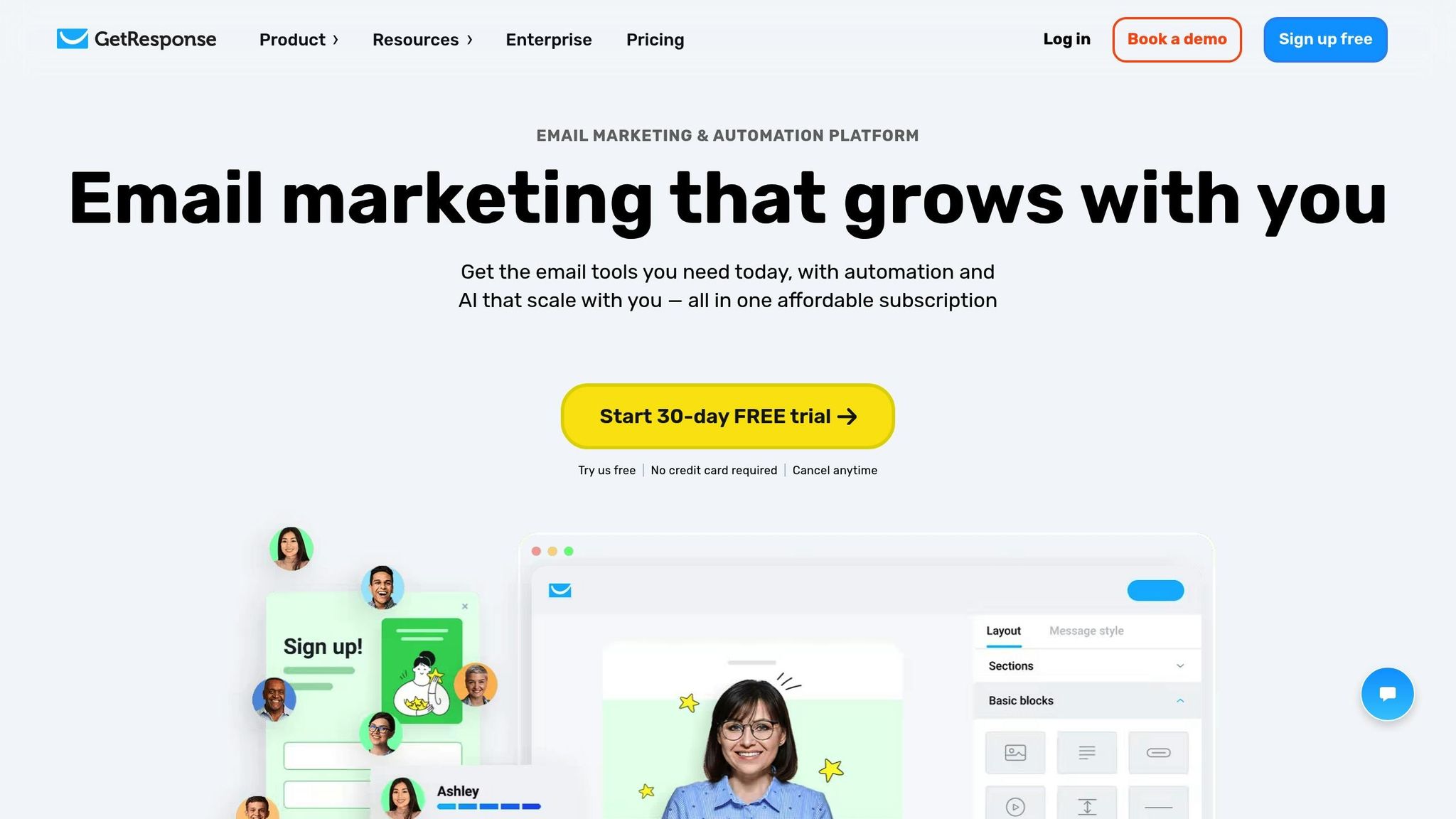
GetResponse stands out as a powerful tool for email marketing, combining advanced automation features with an easy-to-use interface to help businesses maximize their returns. Its strength lies in simplifying intricate marketing tasks while delivering measurable outcomes.
Automation Capabilities
GetResponse’s automation tools are designed with simplicity in mind, featuring a drag-and-drop interface that makes creating even the most complex workflows feel straightforward. The platform also provides prebuilt automation templates tailored to different business goals, so you can hit the ground running without starting from scratch.
A standout feature is its ability to monitor website visitor behavior and trigger relevant emails based on specific actions. This allows you to create custom audience segments and send personalized messages that drive engagement and conversions.
Take OTUS, an educational platform for IT professionals, as an example. They utilized GetResponse’s segmentation and tagging tools to build 29 unique automation workflows, boosting their email-driven sales by 200% in just one year. Their open rates also soared from 17.6% to 30% within six months.
"The comprehensible automation panel has allowed us to extend the automation process to very advanced." - Mariusz, 5-star G2 review
The platform also includes AI-powered tools that assist with email creation, offering automated writing suggestions and optimizing send times to ensure emails land when subscribers are most likely to engage.
This robust automation framework ensures precise audience targeting, making your campaigns more effective.
Personalization and Segmentation Features
GetResponse goes beyond automation by enabling businesses to deliver highly personalized messaging. Its segmentation features let you group subscribers based on factors like demographics, behavior, and engagement history.
For example, Submission Technology, a lead generation agency, achieved impressive results by segmenting their audience by gender. Their targeted approach led to unique open rates of 27.58% for females and 23.49% for males, outperforming industry standards by 50% and 28%, respectively.
The platform’s behavioral targeting takes personalization to the next level. Emails can be triggered based on website visits, purchase history, or interactions with previous emails. This approach helps build stronger connections with your audience, moving away from generic campaigns and toward meaningful communication.
Pricing and Scalability
GetResponse uses a contact-based pricing model that adapts as your business grows, making it a fit for companies of all sizes. Here’s a breakdown of its pricing plans:
- Free Plan: $0 for up to 500 contacts
- Email Marketing Plan: Starting at $19/month for 1,000 contacts
- Marketing Automation Plan: Starting at $59/month for 1,000 contacts
- Ecommerce Marketing Plan: Starting at $119/month for 1,000 contacts
- GetResponse MAX: Custom pricing starting at $1,099/month for enterprise-level needs
You can upgrade your plan as your business grows, and paying annually offers up to 18% savings. Each pricing tier unlocks additional features, ensuring you only pay for what you need at your current stage.
Deliverability and Performance Metrics
GetResponse also prioritizes email deliverability, providing tools and analytics to help you refine your campaigns. With features like A/B testing, businesses can experiment and optimize for better results. For instance, Mobile Fun used these tools to achieve an impressive 49.17% open rate after fine-tuning their campaigns.
The platform tracks essential metrics like open rates, click-through rates, bounce rates, and spam complaints. Given that industry averages hover around 39.64% for open rates and 3.25% for click-through rates, GetResponse’s analytics make it easier to benchmark and improve performance.
"The drag and drop interface made creating rather complex automation trees very easy." - Felipe Godoy, 5-star G2 review
Additionally, GetResponse focuses on email authentication and sender reputation management, ensuring your emails consistently land in subscribers’ inboxes rather than being filtered out as spam. This attention to deliverability helps safeguard the success of your campaigns.
2. Moosend

Moosend is an email marketing platform designed to offer powerful tools at a budget-friendly price. Its focus on user-friendly automation and affordable pricing makes it an excellent option for small to medium-sized businesses aiming to get the most out of their email campaigns without overspending.
Automation Capabilities
Moosend simplifies automation with pre-built templates that handle various business needs, like welcome emails or order-based triggers. These templates make it easy to set up campaigns quickly, even for those new to email marketing.
The platform features a drag-and-drop workflow builder that lets users design personalized customer journeys based on specific actions, such as browsing a website, making a purchase, or interacting with emails. This behavior-based targeting helps businesses engage leads more effectively and keep existing customers coming back. These tools provide the foundation for Moosend’s strong personalization features.
"Moosend is a user-friendly, professional platform with a great support team. And the most incredible thing is that it's cost efficient. Thank you Moosend for making my life easier." - Alex Melvani, Membership Officer at WWF
Moosend also integrates seamlessly with CRM systems and other marketing tools, making it easier to use customer data for targeted campaigns. This integration allows businesses to set up detailed automation workflows without needing advanced tech skills.
Triggered emails, like those sent based on user actions, tend to outperform standard newsletters in terms of open and click-through rates, which directly boosts ROI.
Personalization and Segmentation Features
Moosend takes automation a step further with advanced segmentation options. Businesses can divide their email lists into highly specific groups based on factors like demographics, location, behavior, or engagement history. The platform even includes pre-designed segmentation templates that update in real time, ensuring your campaigns consistently target the right audience.
With dynamic content features, Moosend allows businesses to customize emails within the same campaign. For example, you can show different product recommendations based on a subscriber’s purchase history or create location-specific offers.
Personalized subject lines alone can increase open rates by 26%, while targeted emails generate three times the revenue per email compared to generic ones. Segmented campaigns also see a 100.95% higher click rate than non-segmented ones, leading to better engagement and higher returns.
Pricing and Scalability
Moosend’s pricing is designed to be accessible for businesses of all sizes. It offers a 30-day free trial - no credit card required - so users can explore its features before committing to a paid plan.
The Pro plan starts at $9 per month for up to 500 contacts, with pricing increasing as your list grows. Opting for annual or biannual payments can save you up to 15%, helping to lower overall marketing costs.
For businesses with irregular email needs, Moosend provides a pay-as-you-go option:
- 350,000 credits: $350
- 500,000 credits: $500
- 750,000 credits: $750
- 1,000,000 credits: $1,000
This flexibility lets businesses match their spending to their actual email usage, offering a cost-effective way to manage campaigns.
Deliverability and Performance Metrics
Moosend includes A/B testing tools to help businesses refine their campaigns. You can test different subject lines, email content, or send times to find what resonates best with your audience. Over time, this data-driven approach helps improve campaign performance and boosts ROI.
"Thanks to Moosend our clients are always happy. User-friendly dashboard, amazing support, great tools & automations help our business grow, and our clients deliver outstanding results." - George Levetikos, Chief Integration Officer, MullenLowe Group
With email marketing delivering an average ROI of $42 for every dollar spent, Moosend’s affordable pricing and robust features make it a strong choice for businesses looking to maximize their marketing efforts.
3. ActiveCampaign
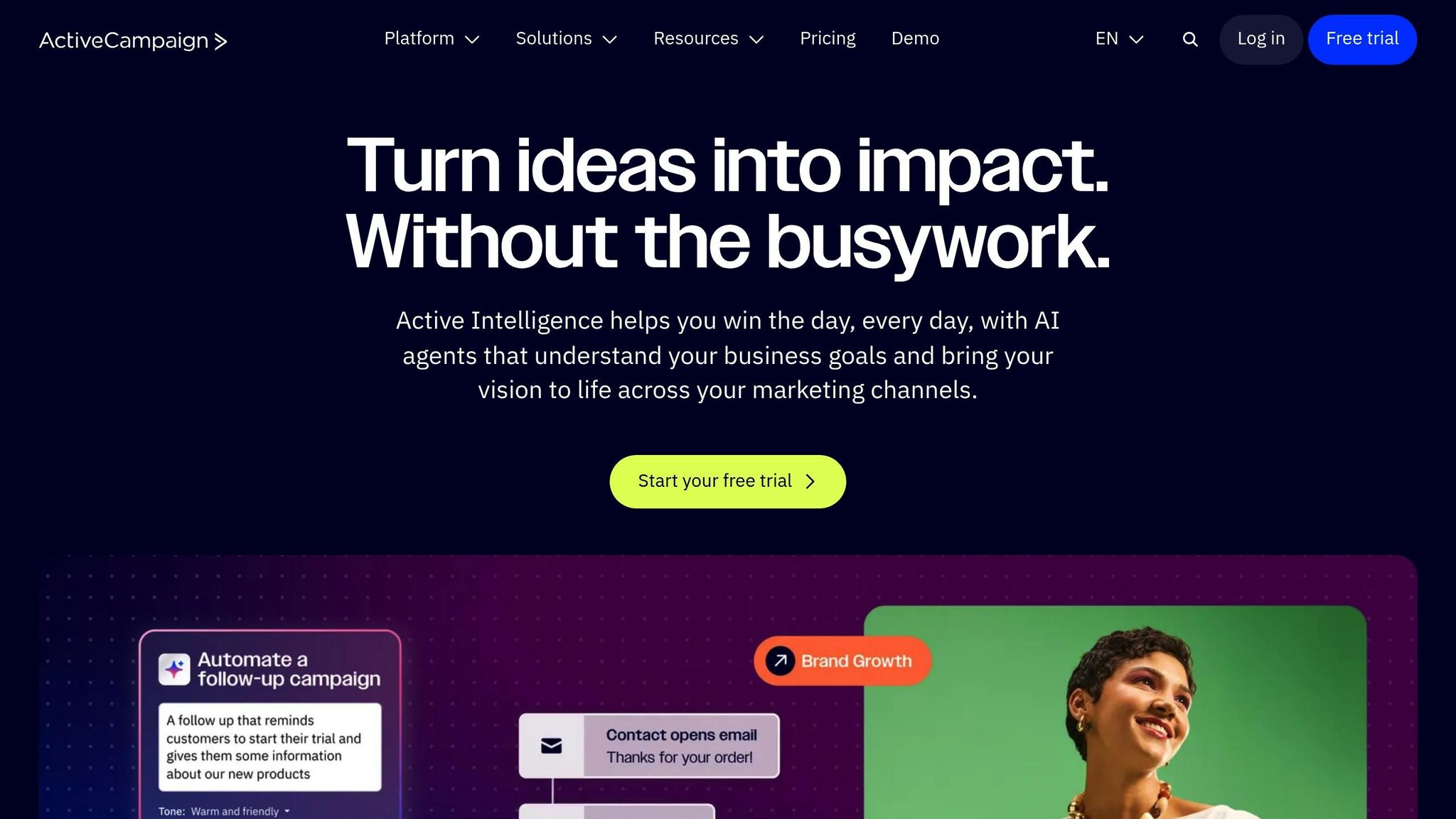
ActiveCampaign is a powerful platform that blends advanced automation tools with CRM capabilities, designed to enhance ROI through campaigns driven by customer behavior.
Automation Capabilities
ActiveCampaign goes beyond basic email automation by offering workflows that adapt to customer actions. These workflows can be tailored to respond intelligently to how users engage with emails, websites, and other interaction points.
"Automations can save you time, help you stay organized, and make more money by improving your marketing and sales processes. After an automation is set up, it can run with no input from you, so creating automations is an extremely high-leverage activity." – ActiveCampaign Help Center
The platform doesn’t stop at marketing automation - it also streamlines sales processes. Features like automatic lead qualification, deal management, and lead distribution ensure smoother operations. By reacting to customer behavior, these automations create more personalized experiences, leading to better engagement and higher conversion rates.
For example, in 2025, ActiveCampaign spotlighted Swim University, which saw a 66% increase in revenue by using scheduled email campaigns.
Personalization and Segmentation Features
ActiveCampaign excels at helping businesses target their audiences with precision. Its segmentation tools allow users to group contacts based on factors like location, website behavior, purchase history, or quiz results. Dynamic content features further enhance personalization by pulling customer data into email templates, ensuring each message feels tailored.
The platform also uses AI to suggest audience segments by analyzing behavior patterns, making it easier to create targeted campaigns. Its lead scoring system assigns points to contacts based on their interactions, helping businesses focus on the most engaged prospects. Research backs this approach: segmented and personalized campaigns account for 77% of marketing ROI, and 93% of B2B professionals report growth through personalization.
This focus on targeted engagement makes ActiveCampaign a strong choice for businesses aiming to maximize efficiency and results.
Pricing and Scalability
ActiveCampaign offers four pricing tiers, scaled to fit businesses at different growth stages. Pricing is based on the number of active contacts, making it easy to expand as your business grows.
| Plan | 1,000 contacts | 2,500 contacts | 5,000 contacts | 10,000 contacts | 25,000 contacts |
|---|---|---|---|---|---|
| Starter | $19/month | $49/month | $99/month | $189/month | N/A |
| Plus | $59/month | $119/month | $179/month | $239/month | $489/month |
| Professional | $89/month | $169/month | $235/month | $419/month | $709/month |
| Enterprise | $159/month | $289/month | $425/month | $665/month | $989/month |
The Starter plan, priced at $19/month for 1,000 contacts, includes basic automation but limits users to five automation actions. The Plus plan removes these restrictions and introduces advanced tools, while the Professional and Enterprise tiers provide features like custom reporting and deeper integrations. ActiveCampaign also offers a 14-day free trial and a 20% discount for non-profits. Email sending limits vary by plan: Starter and Plus allow up to 10 times the contact limit, Professional offers 12 times, and Enterprise provides 15 times the contact limit.
Deliverability and Performance Metrics
ActiveCampaign pairs its flexible pricing with strong performance. With an average user satisfaction rating of 4.6 out of 5 from 2,074 reviews, it ranks among the top 0.1% of email marketing tools. The platform’s A/B testing features integrate seamlessly with its automation tools, enabling businesses to fine-tune entire customer journeys and consistently improve campaign results.
4. Omnisend
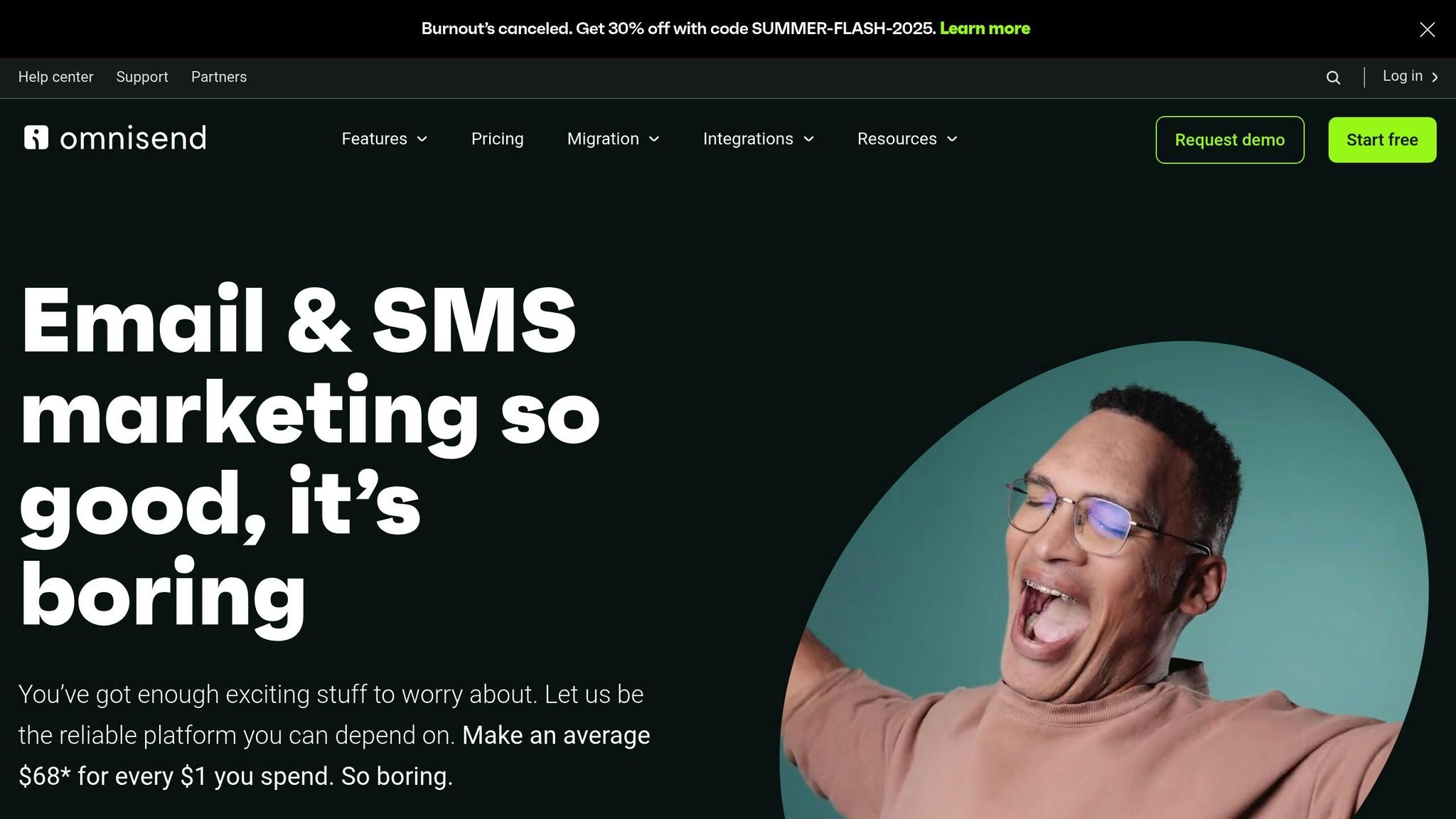
Omnisend stands out as an omnichannel marketing platform tailored for e-commerce businesses. By combining email, SMS, and web push notifications, it helps businesses create unified campaigns that deliver impressive returns on investment.
Automation Capabilities
Omnisend simplifies campaign automation with pre-built e-commerce workflows and an intuitive drag-and-drop editor, seamlessly integrating email, SMS, and web push notifications into cohesive, automated campaigns [42, 43].
According to Omnisend, automated emails account for 37% of sales while representing just 2% of email volume. In fact, 30% of the platform's sales come from automations, resulting in a $65,000 boost in revenue per email [41, 43].
"We see amazing results from our automated emails. Our cart abandonment especially stands out with an 87% conversion rate and $7.44 revenue per email." - Allison Caufield, Senior Marketing Manager at FiGPiN
Naked & Famous Denim experienced a 38% conversion rate and a staggering 4,400% revenue increase with a custom abandoned cart email series.
Omnisend also includes features like A/B testing and automation splits, enabling businesses to test different channels, incentives, and subject lines to optimize their workflows. This focus on automation makes it easier for businesses to deliver highly relevant messaging to their audiences.
Personalization and Segmentation Features
Omnisend uses over 500 data points to create precise email segmentation. Businesses can target campaigns based on factors like demographics, purchase history, and engagement levels. Segmented campaigns have shown to deliver a 62.2% higher order rate.
The platform’s personalization goes far beyond basic name tags. Dynamic email content adapts to recipient profiles, incorporating elements like wish lists (which achieve a 35.67% open rate), purchase history, and browsing behavior. SMS campaigns can also include personalized details such as names, addresses, and order updates.
For example, WindWater Real Estate uses customer website activity to trigger follow-ups. When a visitor views an exclusive property but doesn’t take action, they receive a personalized email emphasizing the property’s limited availability. This approach is crucial, as 76% of shoppers express frustration when brands fail to personalize communication.
"Personalisation is the content, the imagery, the tone of voice… even the time in which the campaign is sent – tailored to the individual. It's about going beyond bundling people into segments, and starting to deliver campaigns to a 'segment' of ONE." - Mike Hall, Email Marketing Director at Jellyfish
Pricing and Scalability
Omnisend offers a flexible pricing model that grows alongside businesses, with three main tiers and custom options for enterprise clients. The Free plan supports up to 250 contacts and includes 500 emails, 60 SMS, and 500 web push notifications per month. While it includes essential features like templates and automation, it does display Omnisend branding.
| Contacts | Free Plan | Standard Plan | Pro Plan |
|---|---|---|---|
| 1,000 | $0 | $20/month | $59/month |
| 5,000 | N/A | $81/month | $90/month |
| 10,000 | N/A | $132/month | $150/month |
| 25,000 | N/A | $282/month | $400/month |
| 50,000 | N/A | $413/month | $715/month |
The Standard plan starts at $16/month for 250 contacts and allows up to 12 email sends per contact. For $59/month, the Pro plan offers unlimited emails, web push notifications, advanced reporting, and 24/7 priority support. For businesses managing over 150,000 contacts, custom pricing is available.
Deliverability and Performance Metrics
Omnisend’s e-commerce focus translates into strong performance metrics. Automated campaigns, including order confirmations, significantly impact revenue, contributing to a $65,000 boost per email and accounting for 17% of annual revenue.
The platform’s reporting tools provide detailed insights into sales and engagement, helping businesses refine their workflows over time. A/B testing further enhances performance by allowing companies to experiment with different messaging, timing, and channels.
sbb-itb-6e7333f
5. Email Service Business Directory
The Email Service Business Directory is designed to help businesses get the most out of their email marketing efforts. By offering a curated selection of tools and strategies, it goes beyond being a simple platform - it provides a clear roadmap for choosing the best email marketing solutions to maximize returns.
Platform Comparison and Selection Features
This directory is all about helping businesses make informed decisions. It features in-depth reviews and side-by-side comparisons of various email marketing services, making it easier to pinpoint the right tools for specific needs. From automation platforms like Smartlead.ai and Instantly to deliverability-focused tools like WarmupInbox, and testing solutions such as EmailToolTester, the directory offers a wide range of options. This allows businesses to create a tailored email marketing stack, perfectly suited to their goals. Alongside these listings, you'll also find expert insights and pricing details to guide your choices.
Expert Guidance and Best Practices
The directory doesn’t just stop at tools - it also equips businesses with actionable strategies. Through blogs and guides written by industry experts, it provides advice on platforms, techniques, and best practices. Whether it's A/B testing, using dynamic content, or incorporating live elements in emails, these resources are designed to help brands fine-tune their campaigns and improve their return on investment.
Pricing and Scalability
To accommodate businesses of all sizes, the directory offers three pricing tiers:
- Boost Plan: At $299, this plan includes essential tools and basic analytics for up to 1,000 contacts. It’s ideal for small businesses just starting out with email marketing.
- Advanced Plan: For $999, this tier adds automation, advanced analytics, and CRM integration, supporting up to 10,000 contacts.
- All-in Plan: Priced at $2,999, this option provides full access to all features, priority support, and unlimited contacts, making it perfect for large enterprises.
Performance Optimization and Analytics
The directory emphasizes the importance of tracking and improving key deliverability metrics to enhance email performance. It highlights maintaining spam rates below 0.1% (preferably under 0.03%) and bounce rates at or below 0.3%. Leveraging third-party analytics tools can significantly improve ROI, moving it from 37:1 to 45:1, while following a thorough pre-send checklist can boost ROI from 28:1 to 40:1. These strategies aim to help businesses achieve deliverability rates of 95% or higher.
"Deliverability is a measure of the health of your email marketing program, so it's important to do regular check-ups on your domain, IP, and authentication in particular to make sure you're up-to-date, just like how we all go to the doctor each year." - Carin Slater, Manager of Lifecycle Email Marketing at Litmus
6. Mailchimp

Mailchimp is one of the most popular email marketing platforms, offering tools like advanced automation, detailed audience segmentation, and performance tracking to help businesses achieve better results. While its pricing can be on the higher side, the platform's features can significantly improve email marketing efforts when used effectively.
Automation Capabilities
Mailchimp simplifies email marketing with automation tools like preset triggers and customizable sequences. Businesses with connected stores can use features like customer journey maps and drip campaigns to stay engaged with customers and increase sales.
The numbers speak for themselves: marketing automation flows have been shown to generate up to four times more orders for users with connected stores compared to traditional bulk emails. Additionally, automated emails created through these flows can boost click rates by as much as 127% when compared to standard bulk emails.
Some real-world examples highlight these benefits. Happy Socks created a three-part email series for customers after their first purchase. The sequence included a thank-you message, an introduction to the brand and its products, and a promo code for future purchases. This campaign achieved a 20% higher open rate and a 50% higher click rate compared to their average campaigns.
Topo Designs, on the other hand, experimented with different offers in their abandoned cart emails to find the most effective and profitable incentives. Their abandoned cart emails now consistently achieve a 20% click-through rate.
These automation features make it easier for businesses to create personalized and impactful campaigns.
Personalization and Segmentation Features
Mailchimp offers robust tools for segmenting audiences and personalizing messages. Businesses can tailor automated emails based on subscriber preferences, demographics, or engagement levels. This level of personalization helps deliver content that resonates with each customer.
The results are impressive. Campaigns featuring product recommendations generate 31% more revenue compared to those without. Even more striking, personalized recommendations in emails can boost sales per email opening by an average of 150%.
Welcome messages are another example of how personalization pays off. These emails are read four times more often and receive five times more clicks than standard marketing emails. They also generate up to 320% more revenue per email than other promotional messages.
"The Mailchimp + Zapier integration allows us to save time and also allows us to accurately segment the audience that we wish to target and just makes everything seamless." - Louise Lau, Performance Marketing Manager, Shapeways
Mailchimp's segmentation tools not only enhance engagement but also drive revenue growth, making it a versatile option for businesses of all sizes.
Pricing and Scalability
Mailchimp's tiered pricing structure is designed to accommodate businesses at different stages of growth. However, costs can rise quickly as your contact list grows. Pricing is primarily based on the number of contacts in your database.
| Plan | Starting Price | Contact Limit | Key Features |
|---|---|---|---|
| Free | $0 | 500 contacts | 1,000 monthly email sends |
| Essentials | $13-$15/month | 500 contacts | Basic automation, email support |
| Standard | $20-$23/month | 500 contacts | Advanced automation, A/B testing |
| Premium | $350/month | 10,000 contacts | Advanced segmentation, multivariate testing |
While Mailchimp offers powerful tools, it’s one of the pricier options for small to medium businesses. It's also worth noting that the platform charges for all contacts, including unsubscribed ones, which can impact your overall costs.
Nonprofits and charities can take advantage of a 15% discount on their plans. For businesses that don’t send emails frequently, Mailchimp also offers a pay-as-you-go option, though unused credits expire after 12 months.
Deliverability and Performance Metrics
In addition to its automation and segmentation features, Mailchimp ensures strong deliverability rates. Recent data shows its deliverability rates have been consistently high, averaging 91.18% across multiple rounds of testing.
Mailchimp performs particularly well with major email providers like Gmail, Yahoo, and AOL, often achieving 100% deliverability. However, performance with Outlook and Hotmail has been more inconsistent, though recent tests have shown improvements.
The platform uses Omnivore technology to detect abuse and maintain a strong sender reputation. For businesses sending over 100,000 emails per month, Mailchimp offers the option to add a dedicated IP address for $29.95 per month.
Mailchimp also provides authentication tools like DKIM, SenderID, and SPF to improve deliverability. Combined with its list management, testing, and reporting features, these tools help businesses optimize their email campaigns.
Industry benchmarks show that average open rates range between 17% and 36%, depending on the sector. Mailchimp's tools and performance metrics make it easier for businesses to meet or exceed these benchmarks, ensuring their messages reach the intended audience effectively.
7. Brevo (formerly Sendinblue)
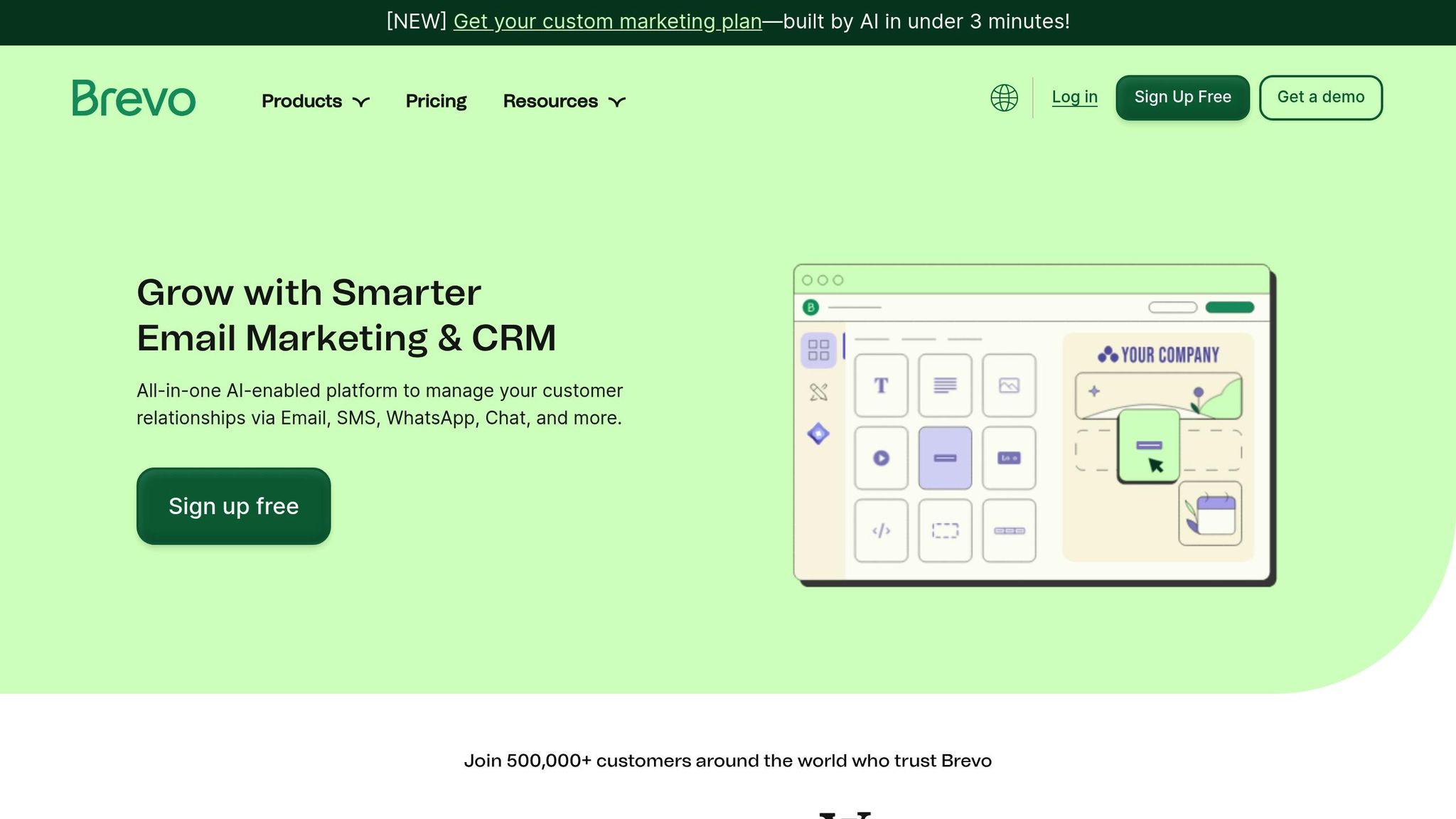
Brevo is an email marketing platform designed to deliver strong returns on investment (ROI) with its flexible pricing structure and advanced automation tools. Unlike many competitors, Brevo charges based on the number of emails sent each month rather than the size of your contact list. This approach can be a game-changer for businesses aiming to get the most out of their marketing budget.
Automation Capabilities
Brevo's automation features are built to simplify campaign management and improve efficiency. With pre-designed templates, a drag-and-drop editor, and the ability to integrate email and SMS campaigns, the platform enables businesses to connect with their audience through multiple channels. This multi-touchpoint strategy boosts both engagement and conversion rates.
Automation workflows can be triggered by a variety of actions, including email interactions, website behavior, and e-commerce activity. For instance, Monisnap, a money transfer service, used Brevo's automation tools to increase customer loyalty by 40% and triple their transaction volume. Additionally, businesses that implement automated abandoned cart emails often see revenue increases of 10–15%.
Brevo also excels in creating personalized communication through its dynamic segmentation tools.
Personalization and Segmentation Features
Brevo allows businesses to craft tailored experiences by leveraging dynamic content and precise audience segmentation. By categorizing audiences based on factors like demographics, behavior, and preferences, businesses can ensure their messages resonate with the right people. Lead scoring further refines this process by identifying prospects with the highest potential for conversion.
The platform's automated welcome email sequences are particularly effective for introducing new subscribers to a brand and fostering early engagement. Advanced "if/then/else" logic enables detailed branching workflows based on subscriber actions, while dynamic content ensures recipients receive messages that align with their interests.
These personalization tools, combined with Brevo's flexible pricing, make it a compelling choice for businesses of all sizes.
Pricing and Scalability
Brevo's pricing model is a standout feature. By charging based on email sends rather than the number of contacts, it offers significant savings for businesses with large contact lists but moderate email volumes.
| Plan | Starting Price | Email Limit | Contact Limit | Key Features |
|---|---|---|---|---|
| Free | $0 | 300 emails/day | 100,000 contacts | Basic automation, templates |
| Starter | $9/month | 5,000–100,000 | Up to 500,000 | Advanced automation, A/B testing |
| Business | $18/month | 5,000–1,000,000 | Unlimited | Advanced segmentation, landing pages |
| Enterprise | Custom pricing | Custom | Unlimited | Dedicated support, custom features |
For businesses with irregular email needs, the Pay As You Go option ranges from $32 for 5,000 emails to $1,600 for 1,000,000 emails.
"Brevo's flexible pricing makes it stand out from the competition. It has 4 pricing plans. Pricing is based on email sends per month and features like automation, AB testing, and advanced reporting."
- Mor Mester, Head of Content Marketing at EmailVendorSelection
Brevo also offers a 10% discount on annual plans. Additional features include the option to remove Brevo branding for $12/month and a dedicated IP address for $251/year.
Deliverability and Performance Metrics
Brevo provides detailed reporting to help businesses track audience engagement and refine their campaigns. Reports include metrics like delivery rates, open rates, click-through rates, conversions, revenue, and unsubscribe rates.
In January 2024, Brevo achieved an 88.3% deliverability rate, with Gmail accounts often seeing a 90–100% success rate. The platform also filters out bot interactions to ensure accurate performance data.
To maintain sender reputation, Brevo automatically blocklists contacts with hard bounces. It advises keeping unsubscribe rates below 1% and complaint rates under 0.2% to avoid account suspension. High-volume senders can opt for dedicated IP addresses, offering greater control over their sender reputation.
With its robust reporting tools and strong deliverability rates, Brevo equips businesses with the insights needed to fine-tune their email marketing strategies and achieve better results.
Platform Comparison Table
When selecting an email platform, it’s crucial to evaluate how each option performs in key areas that influence ROI. Below is a comparison of seven platforms, highlighting their pricing, automation features, personalization tools, and more.
| Platform | Starting Price (USD) | Automation Capabilities | Personalization Features | Deliverability Rate | Best Suited For | G2/Capterra Rating |
|---|---|---|---|---|---|---|
| GetResponse | $15.58/month | Advanced list management, triggered campaigns, segmentation, tagging | Dynamic content and advanced segmentation | High | Content creators, conversion-driven businesses | 4.1/5 (Trustpilot) |
| Moosend | $16/month | Comprehensive workflows with behavioral triggers | Robust personalization and segmentation | High | Growing businesses, budget-conscious users | 4.7/5 (G2), 4.6/5 (Capterra) |
| ActiveCampaign | $15/month | CRM integration and complex automation workflows | Behavioral tracking, lead scoring, dynamic content | High | Businesses needing advanced automation and CRM tools | 4.5/5 average |
| Omnisend | $16/month | E-commerce-specific workflows like cart recovery and cross-sell campaigns | Behavioral segmentation, product recommendations | High | E-commerce businesses | 4.7/5 (Capterra), 4.6/5 (G2) |
| Email Service Business Directory | $299/month (Boost plan) | Basic automation tools for email marketing | Targeted messaging via segmentation | High | Small to enterprise-level businesses | Custom solution |
| Mailchimp | $13/month (Essentials) | Wide range of triggered campaigns, app integrations | Basic personalization and limited segmentation | 98% | Small businesses, beginners | 4.3/5 (G2), 4.4/5 (Capterra) |
| Brevo (formerly Sendinblue) | $9/month | Goal-based campaigns, lead scoring, SMS integration | Dynamic segmentation and personalized workflows | High | Budget-conscious businesses with flexible needs | 4.5/5 (G2), 4.6/5 (Capterra) |
This table offers an at-a-glance comparison, but the real value lies in how these platforms align with specific business goals. For example:
- GetResponse is a standout for content creators, offering tools that focus on increasing conversions. Its advanced automation capabilities shine on higher-tier plans.
- ActiveCampaign is ideal for businesses requiring complex workflows and CRM integration, though its pricing may be higher than some competitors.
- Omnisend caters specifically to e-commerce businesses, with features like cart recovery and pre-built templates that simplify campaign setup and boost revenue potential.
- Brevo provides a cost-effective option for businesses looking for affordable automation tools without sacrificing quality.
- Mailchimp remains a user-friendly choice for beginners, offering basic personalization and straightforward setup.
- Email Service Business Directory positions itself as a premium solution, with enterprise-level features designed to accommodate businesses of all sizes.
An important trend across these platforms is the growing use of AI for audience segmentation and content creation. Many also offer free plans, allowing businesses to explore automation features before committing to a paid option. Studies show that businesses using automation software generate twice as many leads compared to those that don’t. This makes automation a key factor when choosing the right platform for your email marketing strategy.
Conclusion
Choosing the right email platform starts with understanding your needs, budget, and growth plans. With email marketing delivering a staggering $36 for every $1 spent - an impressive 3,600% ROI - your decision can have a major impact on your business's success.
If you're budget-conscious, platforms like Brevo and Moosend are excellent starting points, both priced at $9/month. For e-commerce businesses, Omnisend offers features like cart recovery and product recommendations, making its $16/month starting price a smart investment.
For businesses with more complex needs, ActiveCampaign provides advanced CRM integration, while content-driven marketers may find GetResponse effective for boosting conversions. If you're operating on a larger scale and need enterprise-level tools, the Email Service Business Directory offers plans starting at $299/month, which include advanced features and priority support.
Automation and segmentation are key to achieving the high ROI that email marketing promises. Most platforms provide these essential tools, so your decision should weigh factors like pricing and user experience.
Take advantage of free trials to test each platform's interface, automation capabilities, and customer support. Keep in mind that 56% of email opens happen on mobile devices, so prioritize platforms with mobile-friendly, responsive templates.
FAQs
How do I choose the right email marketing platform for my business and budget?
To choose the right email marketing platform for your business, start by pinpointing your specific needs. Think about what matters most - whether it’s automation, detailed analytics, or seamless integration with your existing tools. Once you’ve outlined your priorities, take a close look at pricing. For small to medium-sized businesses, typical costs range from $50 to $1,000 per month.
Beyond cost, consider other key factors like ease of use, email deliverability rates, and the quality of customer support. Matching a platform’s features and performance to your budget and goals will help you find the solution that maximizes the return on your email campaigns.
What should I look for when choosing an email marketing platform to maximize ROI?
When choosing an email marketing platform to maximize ROI, prioritize features like audience segmentation, personalization, and email deliverability. These are crucial for ensuring your messages reach the right audience with the perfect timing and content.
You’ll also want to keep an eye on performance metrics such as open rates, click-through rates, and conversion rates, as they directly influence your campaign's success. Don’t overlook the importance of keeping your email list clean and using proper sender authentication - both can significantly boost deliverability and overall effectiveness. By aligning these factors with your business objectives, you can select a platform that truly enhances your return on investment.
How do automation and personalization improve email marketing ROI?
Automation and personalization play a crucial role in driving better results from email marketing efforts. Automation simplifies time-consuming tasks like scheduling emails, segmenting audiences, and managing follow-ups. This ensures your messages reach the right people at just the right moment, all while saving valuable time and resources.
On the other hand, personalization takes engagement to the next level by crafting content that resonates with individual preferences. This approach leads to higher open rates, improved click-through rates, and, ultimately, more conversions.
When combined, these two strategies not only deliver relevant and timely messages but also enhance the overall customer experience. This can strengthen brand loyalty and drive sales, all while maximizing long-term ROI. Together, they allow businesses to fine-tune their email campaigns and achieve standout results with less effort.
